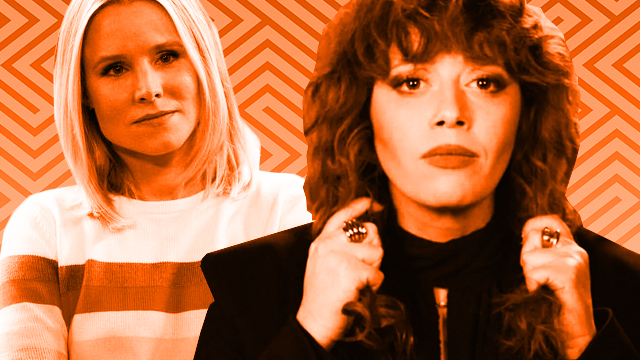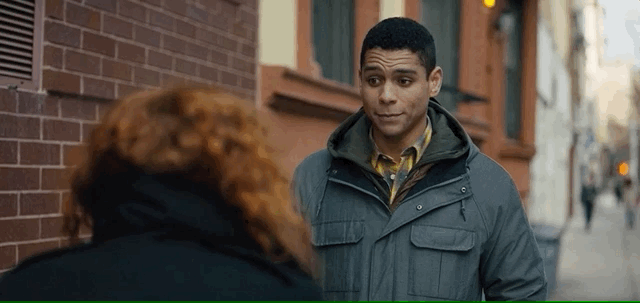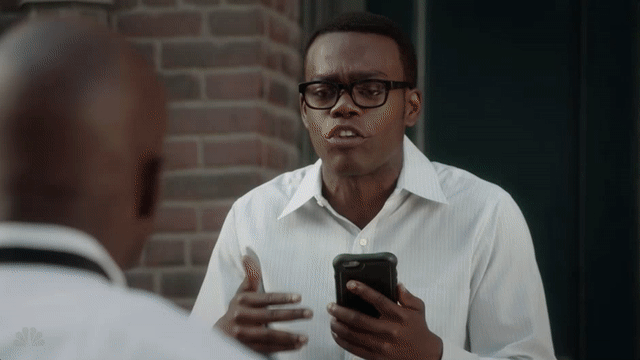
Russian Doll and The Good Place are very different shows. It’s the tone, mostly. The Good Place is bright and fun, Russian Doll is dark and a little meaner. It’s also the style. Russian Doll is set in New York City, in all of its grime, with open sewer grates and teeny tiny kitchens and 3 a.m. stops at a bodega. The Good Place is set in a fictional afterlife paradise (or rather, something approximating that for evil purposes), with an idyllic downtown and bushy green trees and so very many colors. If Nadia from Russian Doll met anyone from The Good Place, she would roll her eyes, take a drag off of the cigarette dangling from her lips, and walk away.
There are also a bunch of similarities between the shows. Both are about flawed-but-charismatic trainwrecks (Nadia, Eleanor) who die unexpectedly at a young age and, through the power of many reboots and the assistance of an overly cautious high-strung man (Alan, Chidi), despite a higher power messing with them (unseen rascal universe-manipulator, assorted well-dressed demons), they try to correct the errors they made before their death, many of which can be sourced to a weird relationship with their troubled mothers (mentally unbalanced, selfish alcoholic). Also, both shows killed people with a falling air conditioner. That should be noted somewhere, by someone, so it will be, here, by me.


And so on. There are other small similarities if you want to dig deeper, which I’m sure someone somewhere will do or has already done. There’s even a behind-the-scenes similarity: Russian Doll is produced by Amy Poehler, who starred in Parks and Recreation, which was created by Michael Schur, who also created The Good Place. There are layers here. That’s what I’m getting at.
Most of these are coincidental, though, and not really the point. The real similarity between the shows is their message and their worldview. For all the differences in style and tone that I laid out in the first paragraph, Russian Doll and The Good Place are still related in a larger way. They might not be siblings, or even direct blood relatives, but at the very least they’re some sort of cousins. Spiritual second cousins, maybe. They see each other at the family reunion and some weddings.
It’s a philosophy thing, mostly. Russian Doll is most often compared to Groundhog Day for obvious reasons, but its message of “you make a connection with a person and teach each other a better way to live” is very much a Good Place message, too. They’re both a little sad — Nadia dying in front of Ruth, Eleanor and Chidi losing their relationship to try to save the afterlife — and profound and relentlessly optimistic. They both give their characters moments of almost pure victory, Russian Doll in its moving finale and The Good Place in scattered bits dropped between new disasters, which need to keep occurring because the show has not reached a logical stopping point yet.
In a way, Russian Doll is somehow even more relentlessly optimistic than The Good Place. Its characters are more messed-up to begin with (Alan is suicidal, Nadia is basically killing herself slowly via a series of vices and bad decisions), and they work to fix each other without the assistance of bow-tied architects and all-knowing Janets. It’s a statement about the resilience of the human spirit and the ability people have to improve and grow. To watch its two main characters, Nadia and Alan, free themselves from the loops they’re stuck in (loops, plural, meaning the live-die-repeat one depicted in the show and the self-destructive circles they’re running before we meet them) is to watch two broken people figure out a way to heal themselves by healing someone else. That’s a powerful piece of business, man.
The Good Place gets to the same destination in a sillier way. There are more goofy asides and more food puns and substantially more references to the Jacksonville Jaguars, sure, but it’s also about people helping people. It’s also about the things you would fix if you had another crack at life and how you need other people to help you fix them. Witness Chidi teaching Eleanor ethics and Eleanor helping Chidi chill out. Watch Tahani learn from Jason’s total obliviousness to social standing and Jason learn from Tahani that there’s more to life than dancing and Molotov cocktails. Even Michael and Janet are growing after thousands and thousands of years doing things the same way, with help from the humans and each other. There’s a similar lesson in all of it: It’s never too late to make changes to improve yourself and the best way to get there is by helping people and accepting other people’s help. This is also a powerful piece of business.
It’s pretty cool, really. We’ve got a whole glut of bleak dramas about bad people fighting losing battles with themselves and the systems that keep them down. We’re barraged with bad news in real life on a daily basis. So to have two of our smartest and funniest comedies — three if you count BoJack Horseman, which is much heavier than either of these shows but gets to or near the same place is its upbeat moments — also be deeply affecting treatises on hope and change… well, again, that’s pretty cool. And refreshing. Especially when you look at the different ways they get there.
I still don’t think they’d like each other very much, though, these spiritual cousins. Not at first, at least. They’d get there, though, possibly after being stuck at a table together at one of those aforementioned weddings. They can bond over a bottle or two of champagne and the even more intoxicating allure of judging the people around them. Then, who knows? The point of both shows is the triumph of humanity over outside forces through accepting other people. They’ll probably figure out they have that in common at some point. Hopefully, they won’t have to die first. Maybe a third bottle of champagne will do the trick.






